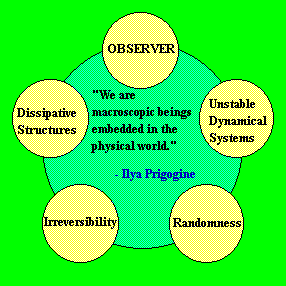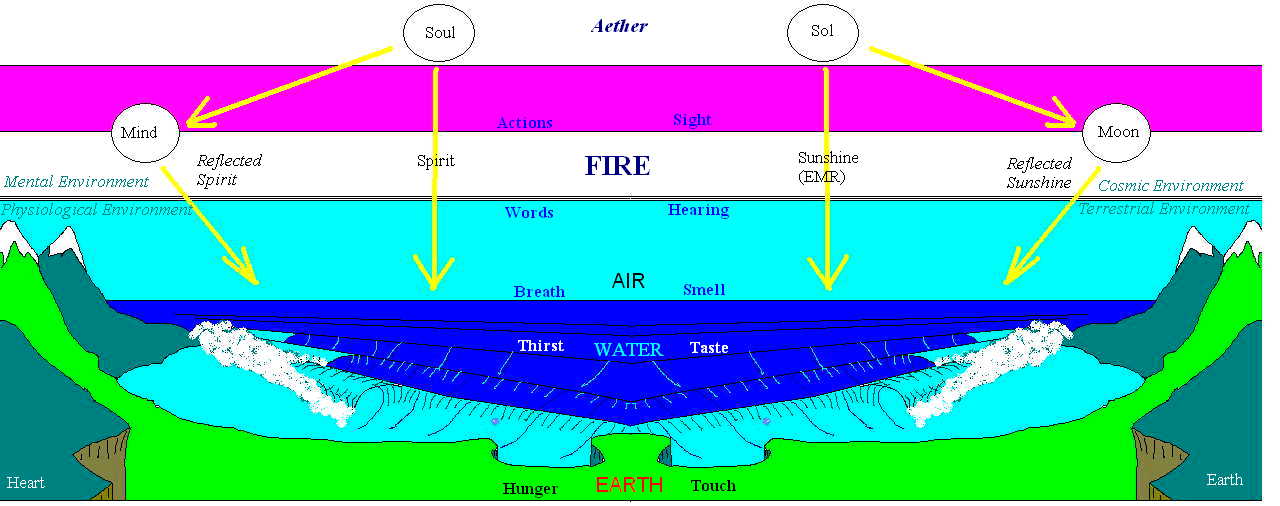The Outer Terrestrial environment is characterised by the interplay
of the at least four elements of nature, fire (here defined as the
Electromagnetic energy which is continuously being transmitted from
the sun, as sunshine, to the earth directly, and to the earth
indirectly via the reflection off the moon. This cosmic energy
continuously enters the Terrestrial planetary environment in the
same manner of a cosmic waterfall flowing into a terrestrial pond.
The cosmic energy - the cosmic fire - is interspersed into the three
elements which are relatively indigenous to the terrestrial environment
and in fact which characterise the planet. Namely the atmosphere (air),
the oceans and rivers and water-cycle system (water) and the earth
itself. We could have followed modern science instead here, and
used the terms gas, liquid and solid matter, and to a certain extent
there is no harm in substituting these terms for a moment to see
how they look in the whole picture.
| The Five Scientific States of Matter ............
| The Five Traditional Elements of Nature ..........
| The Source Environment for each ...
| Solid
| Earth
| Terrestrial
| | Liquid
| Water
| Terrestrial
| | Gas
| Air (Atmosphere)
| Terrestrial
| | Plasma
| Fire
| Cosmic
| | The sub-Quantum substrate
| Aether
| Universal
| |
|---|
To a certain extent we can push the analogy that for those who are comfortable
seeing the planet as composed of one substance called "matter", then we may
say that the solid matter of the planet earth is one substance called earth,
And that the liquid matter on earth is largely water, and the gaseous matter
is the atmosphere - the air itself. Science has found great benefits in
describing the environment in terms of the states of matter. However in
this presentation we shall instead follow the traditional ancient system
of the four elements.
The reason and the benefit for using the ancient system will make itself
known shortly, and involves the relationship between the elements of nature
themselves, and all living creatures, with perhaps a few exceptions.
Let's take a moment to examine each of these.
EARTH
Solid Reliable Dependable Nourishing Earth
All living creatures are closely associated with the solid earth in some
manner. By the solid earth, I mean everything which is neither water or
air - the mountains, the valleys, the beaches, the plains, the ridges,
the floors of the oceans, and the entire substance of the planet beneath
its relatively (very) thin terrestrial crust. The earth is a big shelf.
And all living things depend upon it for their survival.
Every living creature must ingest "earth" of some form in order to remain
alive. We can last perhaps 30 or 40 days without food and after that,
in most cases, if the living being has not ingested earth in the form of
food, then the spirit of life cannot be supported. Every living thing,
and every human, must eat regularly in order to stay alive. In this
sense, earth is an element of survival. We need to eat.
Of course, a nice bowl of rice is not "earth", but for the purposes of
this analogy, we may define all matter which is neither water or air
to be classified quite simply, in the first approximation, as earth.
Our bodies are thus earth, with circulatory liquid systems. We are
also an exchange process, since we must not only ingest food, but excrete
waste products from the body.
| 
|
Demonstrations of impossibility, whether in relativity,
quantum mechanics, or thermodynamics, have shown that
nature cannot be described "from the outside", as if by a spectator.
Description is a dialogue, communication, and this
communication is subject to constraints that demonstrate that
we are macroscopic beings embedded in the physical world.
|
WATER
Elemental Magical Living Water of Life
Water has an unusually high number of anomolous
properties for the scientist. However as each of us understands,
water is also an element of survival, and we cannot live without the
ingestion of water for more than a few days. Our bodies are largely
water, just as the planet earth itself, on the surface, is 70% covered with
a layer of oceanic water.
We must also recognise that water networks extend from the smallest
streams and rivulets on the top of the mountains, to ice and snow,
to the cloud systems around the planet, and to the entirety of the
planets river and stream system. The nature of water provides so
many forms - fog, sleet, hail, snow, mist, and an absolutely organic
and diverse series of clouds. The water cycle is driven by the
sun, raising the waters from the oceanic expanses, and moving the
atmosphere (as wind) to move the clouds of ex-sea water to the mountains
or to a place of rain.
Again we are dealing with a two way exchange process with the environment.
In the external world we need to find a source of water on a regular basis
and we need to return the waste water to the environment. Just like
all other creatures, we are a system which is intricately enmeshed
into the physical world of the terrestrial environment.
What this article seeks to explore is that the recognition of the
integration will greatly increase by using the traditional model
of the elements of nature, because they are also elements of
survival.
AIR
Elemental Magical Living Breath of Fresh Air of Life
So too are we "embedded" within the atmosphere. We must breathe
every few minutes in order to survive. Even a well trained person
can only go without air for a matter of minutes. If the body system
cannot get hold of the element of nature we call air, it
generally will not be able to survive. Note that there is an
IN-breath and an OUT-breath. Again an exchange process with nature.
FIRE
The shine of the sunshine is everywhere penetrated into the terrestrial
environment. The source of the sunshine is not within the terrestrial
environment yet is at the center of the terrestrial envornment. This
sometimes appears to be a paradox.
AETHER
To be discussed separately.

